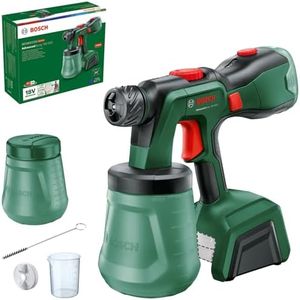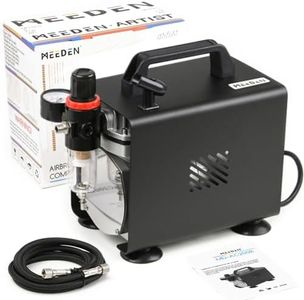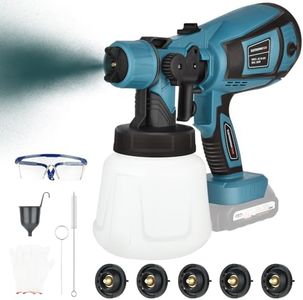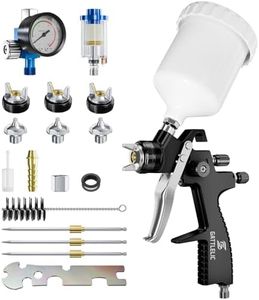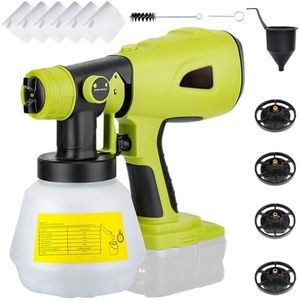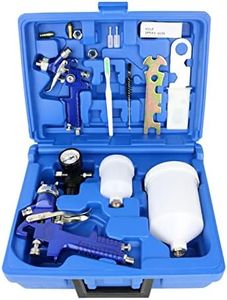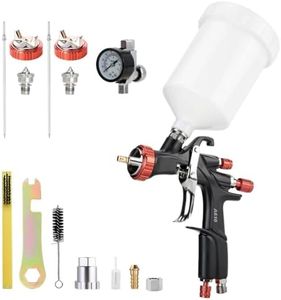We Use CookiesWe use cookies to enhance the security, performance,
functionality and for analytical and promotional activities. By continuing to browse this site you
are agreeing to our privacy policy
10 Best Air Compressor Paint Sprayer
From leading brands and best sellers available on the web.Buying Guide for the Best Air Compressor Paint Sprayer
Choosing the right air compressor for a paint sprayer is essential for a smooth painting experience and a high-quality finish. The main task is to match the performance of your paint sprayer with the output capabilities of the compressor. Selecting the right features ensures you work efficiently, safely, and get an even coat of paint without sputtering, uneven spray, or equipment failure. Pay attention to the core specifications to make sure your compressor can comfortably handle your projects, whether you're painting furniture, cars, or home interiors.CFM (Cubic Feet Per Minute)CFM tells you how much air the compressor can deliver each minute. This is crucial because paint sprayers need a steady flow of air to operate smoothly. Sprayers that need more air than the compressor delivers may spit or stop spraying evenly. Home and DIY sprayers often work with lower CFM (under 5 CFM), while automotive or large projects typically need higher (5-12+ CFM). Figure out what your sprayer requires (check your paint sprayer's manual) and make sure the compressor’s CFM at the required PSI is slightly higher than that—this helps keep the airflow consistent, even as the tank empties. Picking the right CFM is all about matching your sprayer’s demand to the compressor’s output.
PSI (Pounds per Square Inch)PSI is a measure of the pressure the compressor can deliver. Most paint sprayers need a certain pressure, and if the compressor can’t provide enough, the spray won’t be atomized properly, leading to poor coverage. Most DIY and home sprayers work around 30-50 PSI, while professional or automotive tasks may require up to 90 PSI. Always ensure your compressor can consistently reach or exceed the pressure needed for your spraying tasks without dropping. It’s key to know your sprayer’s recommended PSI and make sure your compressor delivers it easily.
Tank SizeTank size tells you how much compressed air the unit stores before the motor has to turn on to refill it. Larger tanks (20 gallons and up) give you longer spraying sessions without frequent stops, making them ideal for big projects like car panels or several pieces of furniture. Smaller tanks (under 10 gallons) are fine for brief, small-scale tasks, but may mean you wait for the compressor to catch up. If you want uninterrupted spraying and a good workflow, pick a tank size that matches the scale and pace of your projects.
PortabilityPortability refers to how easy it is to move and store the compressor. Smaller compressors are lighter and easier to carry around—ideal for quick jobs or painting in different locations. Larger compressors offer more power and capacity but can be heavy and bulky, usually staying in one spot. Think about where you’ll be working: If you move around or have limited space, consider a portable design; if you always work in a garage or workshop, prioritize performance over portability.
Noise LevelNoise level tells you how loud the compressor will be during operation, measured in decibels (dB). Quieter compressors are more comfortable to use, especially indoors or for longer sessions, while louder models might require ear protection and could disturb others around you. If noise bothers you or you’ll be working in noise-sensitive areas, look for models that are specifically designed for quiet operation. Picking a quieter compressor can make your painting projects more pleasant and less disruptive.

